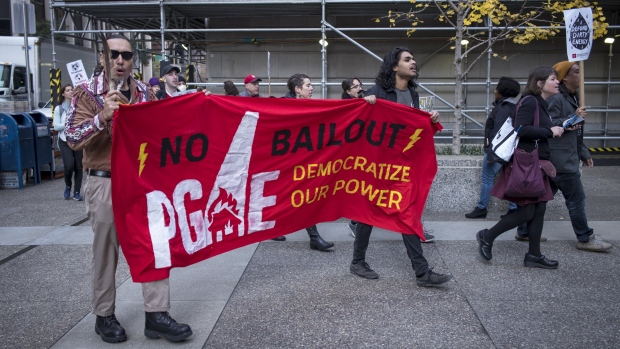Jan 14, 2019
PG&E Bailout Hopes Are Crushed With California Showing Little Interest
, Bloomberg News

(Bloomberg) -- Now that PG&E Corp. has said it plans to file for bankruptcy, analysts are seeing little chance that California lawmakers will step in anytime soon with a bailout for the beleaguered power provider.
California’s largest utility, which faces potential liabilities of $30 billion or more from deadly wildfires, said it will file under Chapter 11 of the U.S. bankruptcy code by Jan. 29, according to a Securities and Exchange Commission filing Monday. Governor Gavin Newsom issued a statement signaling he’s willing to let PG&E proceed, saying that at the same time “the company should continue to honor promises made to energy suppliers and to our community.”
A bankruptcy reorganization would, in fact, allow PG&E to operate and keep the lights on. What’s more, it “diversifies the responsibility for what plays out,” said Kit Konolige, a senior analyst with Bloomberg Intelligence. He said he didn’t believe there was much enthusiasm in Sacramento for an immediate rescue plan. “What politician is going to step up and say ‘I want to save PG&E?’ ’’
There are some, including Democratic Assemblyman Chris Holden, who in a statement called a bankruptcy “deeply concerning for the state.”
The pressure is unlikely to be off politicians to eventually act. Newsom covered that ground in his statement: “I will be working with the legislature and all stakeholders on a solution that ensures consumers have access to safe, affordable and reliable service, fire victims are treated fairly, and California can continue to make progress toward our climate goals.”
PG&E employs 20,000 and provides power to more than 15 million people. Its liabilities could grow from wildfires in 2017 and 2018; the state Department of Forestry and Fire Protection has blamed 17 of the 2017 blazes in part on company power lines and other equipment.
Its stock has tanked, and it has little left in the bank -- $1.5 billion in cash and cash equivalents as of Friday. PG&E has said it doesn’t intend to make an interest payment of about $21.6 million due Tuesday on 5.4 percent senior notes due in 2040.
“There isn’t a lot of time left. You’re talking six months until you actually get into a liquidity crunch,” said Guggenheim analyst Shahriar Pourreza.
Even if they wanted to, Newsom and legislators might simply be unable to do anything in time.
“The high degree of controversy and public outcry stemming from wildfire damages and perceived blame assigned to PG&E likely creates headwinds in the legislative process,” the research firm ClearView Energy Partners LLC said in a report Monday. “The 15-day notice offers a very short runway for lawmakers to act.”
PG&E on Sunday started searching for a new chief executive officer after Geisha Williams, 57, quit; General counsel John Simon will take the helm in the meantime.
Williams’s departure came after a catastrophic period for PG&E. Bonds that traded above face value about months ago now fetch around 85 cents on the dollar. The stock fell as much as 50 percent to $8.77 a share as of 11:10 a.m. in New York, its biggest intraday drop ever. Shares are down 82 percent since the Camp fire broke out Nov. 8.
To contact the reporter on this story: Jim Efstathiou Jr. in New York at jefstathiou@bloomberg.net
To contact the editors responsible for this story: Lynn Doan at ldoan6@bloomberg.net, Anne Reifenberg, Will Wade
©2019 Bloomberg L.P.


